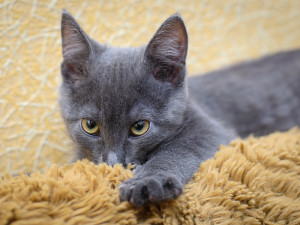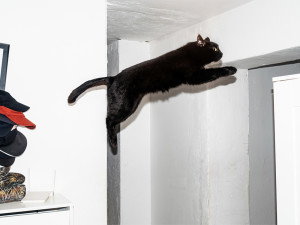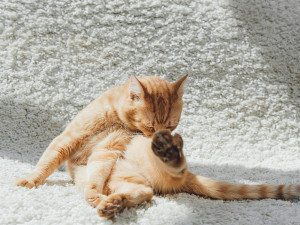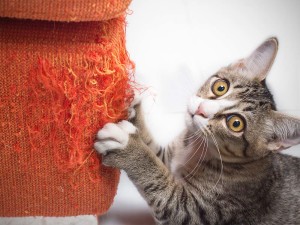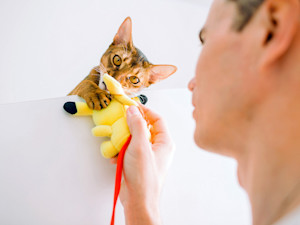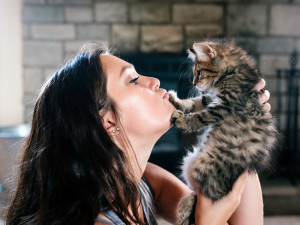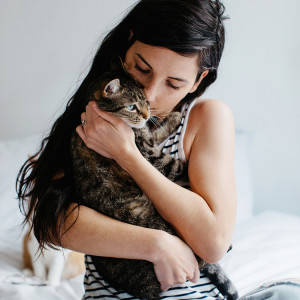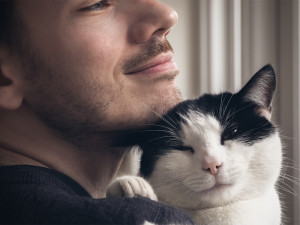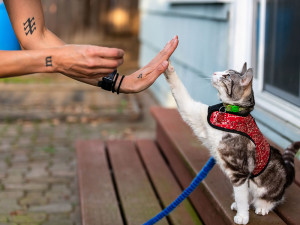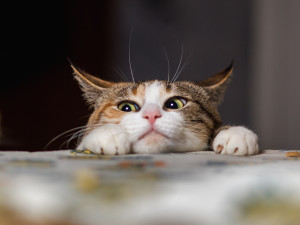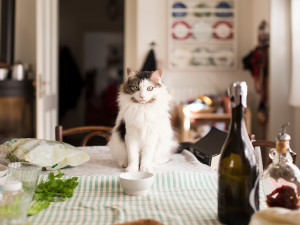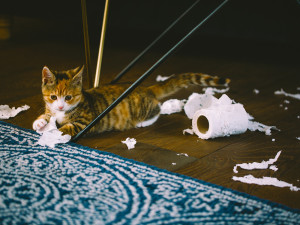What Is ‘Smurgling’ and Why Do Cats Do It?
It’s just one of approximately 10 million adorable behaviours your cat does every day. But why?
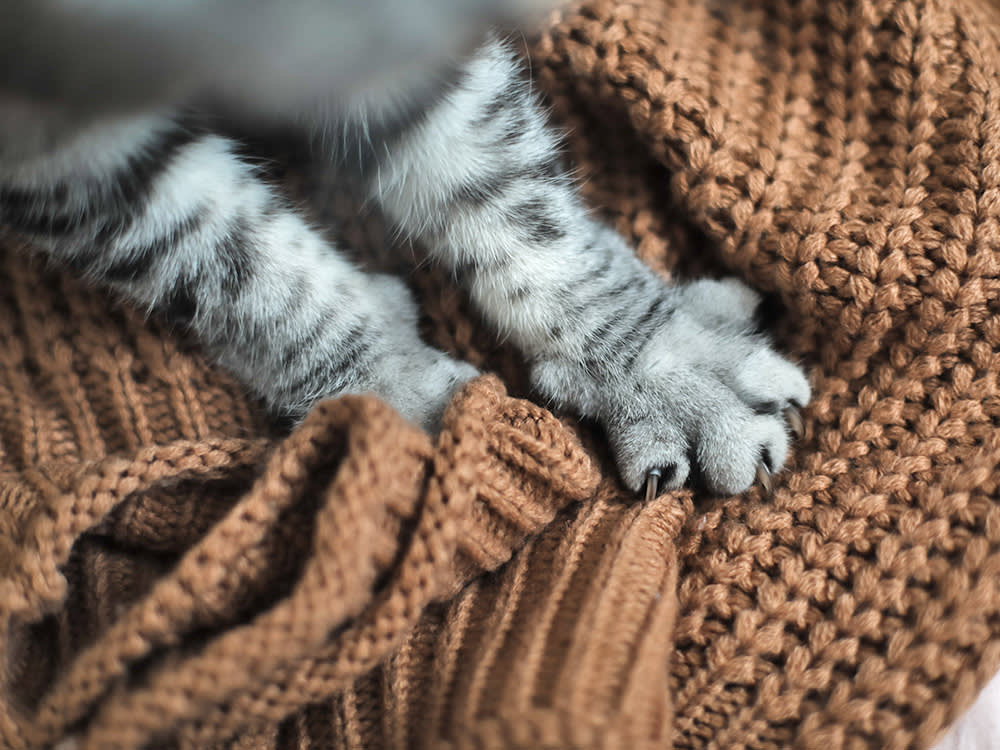
Share Article
If you see your cat rhythmically pressing their paws into your lap, a blanket or even your favourite T-shirt, you’re witnessing the delightful phenomenon of ‘smurgling’.
Also referred to as ‘playing the piano’ or ‘making biscuitsopens in a new tab’ (smurgling kitties resemble bakers kneading imaginary dough), it’s one of the many feline behaviours that leaves pet parents scratching their heads, while simultaneously filming it for social media.

littleKin™ is Kinship’s home just for puppy and kitten parents. Bop over to check out expert advice, new pet tools, and special deals—all curated for your newest family member.
opens in a new tabThe term ‘smurgling’ may sound whimsical, but it perfectly fits this behaviour’s endearing absurdity. Visualise your feline friend purring contentedly as they knead a fleecy blanket with such devotion you’d think it was their life’s work. Some cats even take it a step further; salivating and suckling on the fabric. Yes, it’s adorable, though perhaps less so when the object of their affection is your pricey cashmere jumper.
While smurgling is usually a sign that your kitty is in their happy place, it can occasionally raise eyebrows or questions: is it normal? What if their smurgling ways seem excessive? And why does your cat insist on kneading your thigh right where the flesh is tenderest? We explore what causes your cat to smurgle, to help you to distinguish between endearing activity and potential concern.
What is smurgling?
Bastion of modern language Urban Dictionary opens in a new tabdefines smurgling as, “a singularly feline display of affection. Kneading, purring, nuzzling, or salivating that accompanies feline affection toward humans.” While most cats smurgle in some form, there are many variations of this behaviour. Some cats stick to the classic kneading motion, using their front paws, while others paddle all four feet. Most cats will purr, often really loudly, but some choose to smurgle in silence.
It’s common for smurglers to enter a trance-like state, either closing their eyes or gazing into the distance with a glazed expression. They may drool or suckle, leaving a wet patch on your clothes or their blanket. While it's more common in younger cats who are still transitioning from nursing to adulthood, many adult cats continue to smurgle throughout their lives.
Why do cats smurgle?
To understand why cats smurgle, we need to delve into their evolutionary biology and the feline mind. It’s all about comfort and connection.
Smurgling behaviour originates in kittenhood. When they nurse, kittens instinctively knead their mother’s belly to stimulate milk flow from the nipple (this is why some cats also suckle on soft fabrics or human skin as they knead). As well as serving this practical purpose, it’s also an action associated with feelings of safety and security. But why do so many cats carry this kneading behaviour into adulthood? We still don’t know for sure why smurgling persists after weaning, but cats rarely display behaviour for no reason, and it’s believed that it serves several purposes:
It feels good
The most commonly accepted theory is that smurgling evokes feelings of relaxation, safety and contentment, similar to the comfort cats experience as kittens. It’s a natural, reflexive behaviour that appears to help cats self-soothe if they’re feeling anxious and can become a comforting ritual, just like human thumb-sucking. It’s possible that kneading triggers the release of chemical signals in the brain, elevating levels of mood enhancing ‘happy’ hormones like dopamine and serotonin. If smurgling provides a sense of pleasure, it makes sense for adult cats to keep doing it!
Bonding
In multi-cat households, close companions will often smurgle on one another, creating a reassuring group scent and reinforcing their social bonds. Smurgling on a favourite human is an extension of this social behaviour and a way for your kitty to show affection and demonstrate their trust in you. Smurgling next to you, or while sitting or lying on you, suggests your kitty associates you with comfort and safety, as they’re treating you as a maternal figure.
Instinct
Cats have a rich repertoire of instinctive behaviours that have evolved to help them survive. Just as their predatory instincts are automatically triggered by movement, they are likely hard-wired to start kneading when they feel the sensation of particular textures – such as soft fabric or skin – beneath their paws.
Comfort
Just as we plump our pillows and fluff up the duvet before climbing into bed, cats knead their bed, the sofa or your lap before settling down for a snooze to make their sleeping spot more comfortable. Though domestic cats are descended from the African wildcat, who prefer to sleep in trees as these provide a safe vantage point, other species of wild cat have been witnessed kneading piles of leaves or patches of long grass to create cosy resting places, and our kitties may share this instinct.
Communication
Cats have interdigital scent glands between their toes. When their claws are extended and their paw stretch and flex, these glands release pheromones, which they use to mark their territory – in this case, claiming a favourite sleeping spot (or you!) as their own.
Unneutered female cats also knead when they are in oestrus (also known as going into heat) as a sign to males that they are ready to mate. A cat in heat usually becomes extremely affectionate, restless and vocal, calling loudly and begging to be let outside.
Is smurgling normal?
In most cases, smurgling is a quirky but perfectly normal part of a cat’s behavioural repertoire. However, there’s a spectrum of smurgling from the occasional kneader to the obsessive fabric sucker or chewer. Understanding the difference between typical kneading and excessive or compulsive behaviour can help you determine whether you should be concerned.
Normal smurgling may occur occasionally or daily, usually when a cat is happy, relaxed and being stroked or settling down for a nap. It typically lasts for a few minutes before they curl up in your lap or their bed or move on to another activity. The kneading action is gentle and rhythmic and usually accompanied by purring. It’s concerning if smurgling becomes excessive in frequency or intensity or disruptive to your cat’s routine, interfering with eating, sleeping and playing.
If kneading becomes compulsive, it’s often a sign of underlying illness or stress, anxiety or frustration. Just like humans, cats can channel boredom or stress into repetitive actions. If you notice that your kitty’s smurgling is triggered by common stressors such as loud noises, visitors or intruder cats, your cat is likely anxious and using it as a coping mechanism.
It’s not uncommon for smurgling cats to suckle or chew on soft furnishing, clothing or even human earlobes (!). This can sometimes be a sign that they were separated from their mother or weaned too early. If your feline companion starts ingesting fabric or other non-food items, it’s a red flag – this is pica, another compulsive behaviour which can result in life-threatening intestinal blockage.
When should I intervene?
If your cat is a vigorous smurgler, leaving your upholstery laced with holes and your lap beginning to feel like a pin cushion, try using a soft blanket as a barrier between their paws and your furniture or legs. You could train them to relax on a mat (a plush piece of vet bedding or squishy memory foam pad is ideal) so you can move their smuggling station around the house. Alternatively, give them something more appropriate to sink their claws into by redirecting them to a plush toy or a scratching padopens in a new tab.
Don’t reprimand or punish your cat for smurgling – they won’t understand why they’re in trouble, and it can cause fear and anxiety, potentially damaging their bond with you. In rare cases, zoonotic diseases, such as cat scratch disease, can be transmitted from cats to humans via puncture wounds, so if your kitty does unintentionally break your skin with their claws, immediately wash with soap and clean, running water and don’t let them lick your skin. If your cat is constantly getting their nails snagged on your clothes, their bed or other fabrics, keep their claws trimmedopens in a new tab.
If you’re concerned that your cat’s smurgling is abnormal, start noting down when, how often, and in what context the behaviour is occurring. Consider whether there have been any changes in their environment or routine, such as a house move, building work, or the arrival of a new human or non-human family member? Are they under stimulated or unable to engage in natural behaviours? Have you noticed any other changes in their behaviour?
If their smurgling seems excessive or compulsive, or you notice other signs of stress or anxiety, consult your vet to rule out underlying medical conditions which may be causing or contributing to the behaviour. A decrease in smurgling can also be a sign that your kitty is stressed or in pain. For example, cats may stop kneading if they have arthritic paws or ingrown nails pushing into their sensitive pads.
If no medical cause is identified, the vet can refer you to a clinical animal behaviourist who will evaluate the problem, identify the root cause and develop a behaviour modification and environmental enrichment plan tailored specifically for your cat.

Claire Stares, BA (Hons), MA, PG Dip Clinical Animal Behaviour
Claire Stares is a feline behaviourist with a PG Diploma in Clinical Animal Behaviour from the University of Edinburgh Royal (Dick) School of Veterinary Studies. She’s dedicated to helping guardians and their cats overcome behavioural problems and thrive so that they can enjoy life together. A cat lady since babyhood (her first word was cat!), she has over 20 years of experience living and working with cats in homes, rescue environments and veterinary practices. A passionate advocate for training cats for enrichment and cooperative care, she practices what she preaches with her five cats: three rescued Domestic Shorthairs, Bimble, Bertie and Katie, a Siamese called Daisy Mae, and a Maine Coon named Horatio. When there isn’t a feline companion asleep on her laptop, she writes books and articles for various publications.
Related articles
![cat playing with pikachu toy]() opens in a new tab
opens in a new tabHappy Cat, Happy Life: 5 Enrichment Tips to Keep Your Kitty Content
What is enrichment and why is it so important to keep your kitty happy?
![Woman holding brown kitten to her face.]() opens in a new tab
opens in a new tab8 Myths About Your Kitten – Busted By a Behaviourist
Forget everything you think you know...
![dark-haired woman hugging cat that has imprinted on her]() opens in a new tab
opens in a new tab10 Signs Your Cat Has Imprinted On You
Feeling like you have a little shadow these days? A cat behaviourist explains why that’s happening
![cat snuggling man]() opens in a new tab
opens in a new tabWhat’s Your Cat’s Love Language?
Five surprising ways cats show affection (and how you can show it back), according to a cat behaviourist
![Training a cat sitting with leash and harness on.]() opens in a new tab
opens in a new tabA Step-by-Step Guide On How to Clicker Train Your Cat
This popular training technique isn’t just for dogs. Here’s how you can make it work for your cat
![Cat grabbing onto ledge of table and looking to the left]() opens in a new tab
opens in a new tabIs Your New Cat Stalking You?
Yes, they are right behind you
![cat staring at person on table]() opens in a new tab
opens in a new tabWhy is My Cat Giving Me the Evil Eye?
...Is it something I said?
![A calico tabby kitten chewing and tearing a roll of toilet tissue.]() opens in a new tab
opens in a new tabWhy Does My Cat Chew On Everything?
How to decode your cat’s chewing habits when they’re nibbling on all the things
